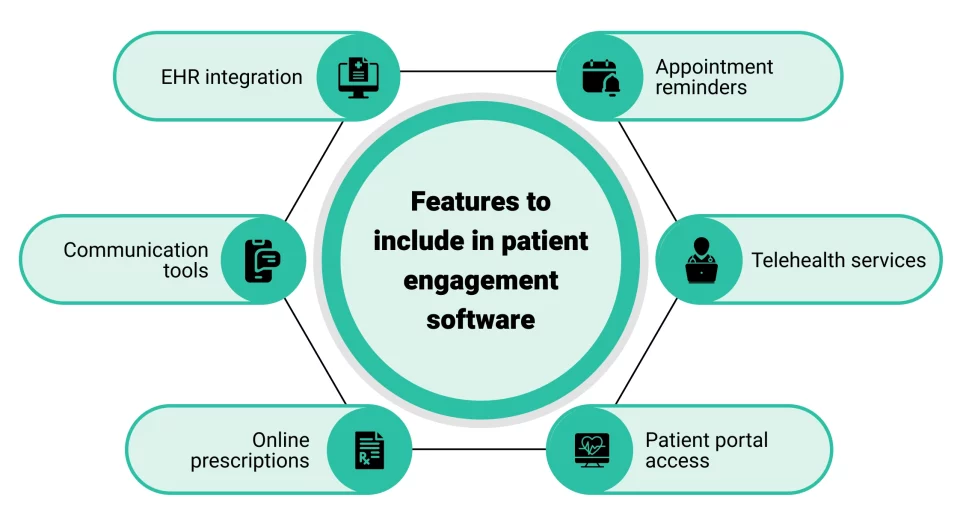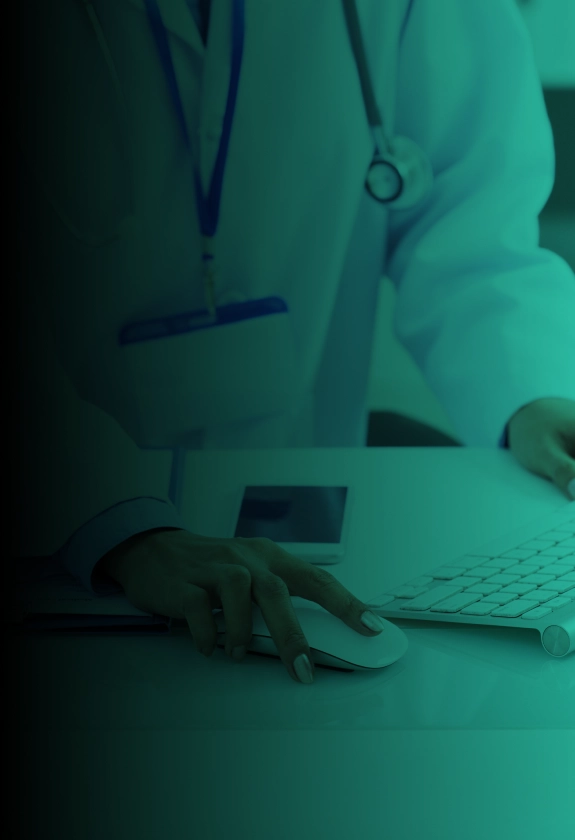INTRODUCTION
When it comes to healthcare software, one-size-fits-all simply doesn’t work. Imagine trying to wear shoes that don’t fit—uncomfortable, right? The same goes for healthcare practices trying to use generic software. Custom software, designed with specific features, is the perfect fit for a practice’s unique needs. Tailored features distinguish between a seamless workflow and a chaotic one, between a smooth patient experience and one full of bottlenecks. With the right tools, practices can address challenges and stay ahead in an increasingly complex healthcare landscape.
What makes custom software so powerful is its ability to adapt. Features like real-time patient data management, easy appointment scheduling, and automated billing aren't just "nice to have"; they're essential for keeping your practice running like a well-oiled machine. These features save time, reduce errors, and improve communication between patients and medical staff, ensuring a seamless experience across the board. Streamlined operations mean less stress, better efficiency, and a more satisfied patient base.
Then, there’s the elephant in the room: compliance. Healthcare is a regulated industry, and the stakes are high. Here, custom healthcare software development plays a vital role in maintaining compliance with strict regulatory requirements such as HIPAA and GDPR. Features like secure data storage, role-based access, and audit trails ensure your practice meets all regulatory standards without skipping a beat. This is the beauty of custom software—it doesn’t just help you stay compliant; it actively supports your practice’s growth by providing scalable solutions that evolve as regulations change. With the right features, your practice survives and thrives in this fast-paced environment.
FEATURES
When developing custom healthcare software, incorporating the right features is crucial to meeting the diverse needs of patients, providers, and administrators. These features streamline workflows, enhance patient engagement, improve data security, and ensure seamless system interoperability. By tailoring these functionalities to your organization’s unique requirements, you can create a solution that drives efficiency, supports compliance, and delivers superior care outcomes.
Patient engagement features
Patient portals
Imagine having your medical history, test results, and appointment details all at your fingertips—accessible 24/7 from anywhere. That’s the magic of custom patient portal development. By offering patients direct access to their medical records, prescriptions, and test results, a patient portal empowers them to take control of their health. This instant access eliminates the need for time-consuming calls or visits to the clinic, streamlining communication between the healthcare provider and the patient. The result? A more informed patient who feels in control of their healthcare decisions, leading to better engagement and trust.
Beyond just providing access to records, a patient portal can facilitate proactive care. Patients can track their health metrics, ask questions, request prescription refills, or schedule follow-ups without waiting for office hours. This added convenience improves satisfaction, reduces no-show rates, and ensures patients remain connected with their care team. A portal that integrates with EHR systems ensures that patients see up-to-date information, which enhances transparency and strengthens the patient-provider relationship.
Telehealth and virtual consultations
Custom telehealth software solutions have transformed healthcare by making it easier for patients to consult with providers from their homes. Custom software can integrate telehealth features like video consultations, virtual check-ups, and remote diagnosis, removing geographic and scheduling barriers to care. Virtual consultations offer unprecedented convenience for patients in rural areas or with busy schedules. Telehealth improves access to care and helps manage chronic conditions, where regular check-ins are necessary but can often be hard to schedule in person.
Virtual consultations also enhance communication between the healthcare provider and the patient. Secure messaging, built into the telehealth platform, allows seamless follow-up conversations without needing face-to-face visits. Whether clarifying medication instructions or addressing minor health concerns, patients appreciate the ease and privacy of messaging directly with their providers. Plus, telehealth platforms that integrate with EHR systems enable providers to document and access patient data in real-time, ensuring that remote consultations are as thorough and effective as in-person visits.
Appointment scheduling and reminders
Gone are the days of calling to schedule an appointment and worrying about forgetting it. Custom healthcare software solutions can simplify the process by offering intuitive, user-friendly appointment scheduling features. Patients can book, reschedule, or cancel appointments through an easy-to-use interface that works across multiple devices. This convenience reduces the administrative burden on medical staff and empowers patients to manage their healthcare on their own terms. Whether it’s a routine check-up or a specialized consultation, allowing patients to choose time slots that fit their schedule leads to higher patient satisfaction and fewer missed appointments.
To take it a step further, automated appointment reminders ensure that patients don’t forget their upcoming visits. Custom software can send reminders via SMS, email, or app notifications, reducing no-shows and last-minute cancellations. This keeps the schedule on track and ensures that patients are more likely to attend their appointments, leading to improved continuity of care.

Don’t settle for less and ensure that your custom software contains these features
Data Management and Interoperability Features
Electronic Health Record (EHR) integration
EHR integration is the backbone of modern healthcare systems, offering a centralized digital platform where patient data is securely stored and easily accessible. By integrating EHR with custom healthcare software, medical practices can ensure that all patient information—from medical history to lab results—is updated in real-time and available at the fingertips of healthcare providers. This reduces the chances of errors, such as misdiagnosis or medication conflicts, because every provider involved in the patient’s care can access the same comprehensive data.
Moreover, EHR integration significantly enhances care coordination. Patients often see multiple specialists or visit different healthcare settings, resulting in fragmented care without integrated records. Custom software solutions that integrate EHR systems allow for a seamless flow of information across healthcare providers, ensuring that all stakeholders are on the same page.
Health Information Exchange (HIE) support
Health Information Exchange (HIE) support takes data sharing to the next level, enabling seamless communication between healthcare organizations and systems. With HIE, patient data can be securely exchanged across hospitals, clinics, and specialists, regardless of each organization's electronic health system. This is particularly important for patients receiving care from multiple providers, as it ensures that their medical history is readily available whenever needed.
In emergencies, HIE support is invaluable, as it allows healthcare providers to quickly retrieve critical patient information from various healthcare institutions, even if the patient cannot provide their medical history. By ensuring that all relevant patient data is accessible across different platforms, HIE fosters better care coordination, enhances patient safety, and minimizes the risks of miscommunication or errors. Custom software solutions incorporating HIE support create a truly connected healthcare ecosystem, enhancing the patient experience and ensuring continuity of care across various healthcare touchpoints.
Data interoperability with other systems
Data interoperability is essential for achieving a truly integrated healthcare system. It allows systems like Electronic Health Records (EHR), laboratory databases, imaging systems, and billing platforms to seamlessly communicate and share patient information. With interoperability, each department or provider would be able to work in collaboration, resulting in cohesive patient data and inefficiencies in care delivery. Custom healthcare software that supports data interoperability eliminates these silos, allowing for smoother and more accurate exchanges of information between various systems.
Data interoperability enhances operational efficiency, as healthcare providers no longer need to enter or transfer data between systems manually. For instance, lab results, patient imaging, and prescriptions can be automatically synced with EHR systems, reducing the risk of data entry errors and enabling real-time updates. For patients, this means they don’t have to repeat their medical history or undergo unnecessary tests when transitioning between healthcare providers.
Security and compliance features
HIPAA compliance and data encryption
HIPAA compliance is non-negotiable in healthcare, as it safeguards patient privacy and ensures that sensitive medical information is handled with the utmost care. Custom healthcare software integrates robust encryption protocols to secure data at rest and in transit, preventing unauthorized access or breaches. This ensures that patient information, from medical records to billing details, remains confidential and protected against cyber threats. With compliance built into the software, healthcare providers can avoid regulatory penalties while fostering patient trust.
Beyond compliance, data encryption strengthens overall cybersecurity by encoding sensitive information, making it unreadable without proper authorization. By incorporating end-to-end encryption and regular compliance audits, custom software solutions provide healthcare organizations with peace of mind and a fortified defense against evolving threats.
Multi-factor authentication and access control
Multi-factor authentication (MFA) is a critical feature that enhances security by requiring users to verify their identity through multiple channels, such as passwords, biometrics, or one-time codes. This added layer of protection reduces the risk of unauthorized access, ensuring that only authorized personnel can retrieve sensitive patient data. Custom healthcare software can also implement role-based access control, granting employees access only to the data necessary for their specific roles, minimizing security risks.
Access control features secure patient data and streamline operations by clarifying data responsibilities within the organization. For instance, administrators, clinicians, and billing teams can access relevant information without overlapping permissions, reducing errors and enhancing accountability. MFA and access control create a secure digital environment prioritizing patient privacy and operational efficiency.
Audit trail and security monitoring
Audit trails are indispensable for maintaining transparency and accountability in healthcare data management. They meticulously track every interaction with the system, recording who accessed or modified patient information and when. These records are invaluable for identifying unauthorized access, spotting potential vulnerabilities, and ensuring compliance with regulations like HIPAA. Custom software with built-in audit trail capabilities allows healthcare organizations to seamlessly monitor and report on their data security practices.
Audit trails provide an active defense mechanism against breaches paired with real-time security monitoring. Continuous monitoring helps detect and mitigate threats as they occur, minimizing potential damage. Custom healthcare software solutions often integrate advanced monitoring tools that flag suspicious activities, enabling healthcare providers to act swiftly and maintain the integrity of their systems. This combination of proactive and retrospective security measures ensures comprehensive protection for sensitive patient data.
Clinical and operational workflow optimization
Electronic Prescription (ePrescription) and order management
ePrescription and order management systems simplify the prescribing process by enabling providers to send prescriptions directly to pharmacies digitally. This eliminates errors associated with handwritten scripts, reduces delays, and improves patient medication adherence. Custom healthcare software can integrate these tools seamlessly into practice workflows, ensuring accurate and efficient medication management while enhancing patient safety.
Additionally, order management streamlines lab test and imaging requests, ensuring clear communication between providers and diagnostic facilities. Automated notifications keep everyone in the loop, minimizing the chances of missed orders or delayed results. These features reduce manual tasks and foster a smoother care delivery process.
Automated billing and claims processing
Automated billing and claims processing features reduce administrative strain by handling complex financial tasks quickly and precisely. Custom software can generate accurate bills, process claims efficiently, and flag potential errors before submission, significantly lowering claim denials and delays. This ensures timely reimbursements, improves cash flow, and allows staff to focus on more value-driven activities.
Furthermore, automation provides transparency by tracking claims in real-time, offering insights into payment statuses and potential bottlenecks. By reducing manual intervention, healthcare practices can save time, cut costs, and enhance overall operational efficiency, creating a win-win for providers and patients.
Customizable workflow for practice needs
Every healthcare practice is unique, and customizable workflows allow providers to tailor operations to meet their specific needs. Custom software offers the flexibility to design workflows that align with clinical processes, administrative requirements, and patient care objectives. Whether managing appointment scheduling or streamlining patient check-ins, tailored solutions ensure seamless functionality.
Customizable workflows eliminate inefficiencies and ensure that tasks are completed effectively by adapting to the practice's size, specialty, and structure. This level of personalization boosts productivity, reduces errors, and empowers healthcare teams to focus more on delivering high-quality patient care.
Advanced analytics and reporting capabilities
Real-time data analytics for decision-making
Real-time data analytics equips healthcare providers with instant access to actionable insights, enabling quick and informed decision-making. Whether monitoring patient vitals, tracking appointment trends, or identifying operational bottlenecks, this feature ensures that providers stay updated on the latest metrics. Real-time analytics can significantly improve care delivery and enhance patient outcomes by addressing issues as they arise.
Moreover, the immediacy of real-time data allows healthcare administrators to respond to fluctuations in demand, such as staffing adjustments during peak hours. This capability optimizes resource utilization and keeps the practice running smoothly while maintaining a high standard of care.
Customizable reporting for clinical and financial insights
Customizable reporting tools transform raw data into meaningful insights tailored to a healthcare practice's unique needs. Clinicians can generate reports to evaluate patient outcomes, treatment success rates, or population health trends, allowing for evidence-based adjustments to care plans. These tools simplify the process of tracking clinical metrics and improve strategic decision-making.
On the financial side, custom reports clarify revenue cycles, billing performance, and claim processing times. Practices can quickly identify inefficiencies, such as delayed reimbursements or underperforming services, and implement corrective measures. Customizable reporting becomes a cornerstone for better management by offering healthcare analytics trends.
Predictive analytics for patient outcomes
Predictive analytics leverages historical data and machine learning to forecast patient outcomes and healthcare trends. By analyzing patterns, this feature can identify at-risk patients, such as those likely to develop chronic conditions or require hospital readmissions. With this foresight, providers can implement preventive measures and allocate resources more effectively.
Beyond clinical applications, predictive analytics supports operational planning by forecasting patient volumes, resource demands, and treatment costs. This ensures that practices are better prepared for future challenges, enhancing patient care and financial stability. Predictive tools empower healthcare providers to shift from reactive to proactive decision-making.
Mobile accessibility and user experience
Mobile-friendly interfaces for patients and providers
In the fast-paced world of healthcare, mobile-friendly interfaces are no longer optional—they are essential. Intuitive designs, clear layouts, and easy-to-use functionalities ensure patients can access their medical records, schedule appointments, and communicate with providers effortlessly. For healthcare providers, mobile-friendly interfaces simplify workflows, enabling quick access to patient information, streamlined communication with care teams, and real-time updates on critical data.
Moreover, mobile-friendly interfaces foster inclusivity by catering to diverse users, including those who rely solely on mobile devices for connectivity. For healthcare providers, such interfaces improve operational efficiency and foster better patient outcomes. Whether through a responsive app or a web-based solution designed with mobile usability, mobile-friendly interfaces bridge the gap between technology and user expectations in healthcare.
User-centered design for easy navigation
User-centered design (UCD) prioritizes the user's needs—whether a patient or a healthcare provider—in the development process. In healthcare software, this means creating intuitive and easy-to-navigate applications, even for users with limited technical expertise. Features like simplified menus, clear labels, and guided workflows reduce frustration and enhance usability, enabling users to focus on their primary objective - accessing or delivering quality healthcare.
UCD ensures patients can quickly locate vital information, such as test results, medication instructions, or appointment details, without confusion. It minimizes healthcare providers' time navigating complex systems, allowing them to devote more attention to patient care. By involving users in the design process, healthcare software can achieve a level of usability that promotes both satisfaction and efficiency.
Cross-platform compatibility
Cross-platform compatibility ensures that healthcare software delivers a consistent and reliable user experience, regardless of the device or operating system used. With patients and providers accessing healthcare apps from smartphones, tablets, and desktops, compatibility across platforms is essential to maintain functionality and accessibility. This approach allows users to switch between devices seamlessly, ensuring no critical tasks are disrupted due to technical limitations.
For healthcare providers, cross-platform compatibility enhances workflow efficiency by enabling access to patient records, telehealth services, and other critical tools from any device, whether in the office or on the go. Patients benefit from the convenience of accessing their healthcare information whenever and wherever they need it, fostering greater engagement and trust.
Do you want to discover the must-haves that can transform your operations and patient care?
FUTURE-PROOF FEATURES
In today’s rapidly evolving healthcare landscape, scalability and flexibility in custom software development for healthcare are no longer luxuries—they are necessities. Imagine a hospital expanding its patient base or integrating new services, only to find its software buckling under the pressure. Scalable solutions ensure your system grows seamlessly with your organization, accommodating increased users, data, and functionality without disruptions. Conversely, flexibility allows your software to adapt to emerging technologies and industry standards, keeping your organization competitive and agile. By investing in future-ready software, you’re not just building for today—you’re ensuring your healthcare system thrives tomorrow.
Now, picture a world where your software can predict patient health risks before they manifest or suggest optimized treatment plans in real-time. This is the transformative potential of AI and ML in healthcare. By integrating these technologies, custom software can uncover patterns in data that humans might miss, offering predictive insights that enable proactive care. From identifying early signs of chronic diseases to predicting patient no-shows, AI/ML tools help healthcare providers make smarter, faster decisions. The result? Better patient outcomes, reduced costs, and an edge in delivering value-based care.
Beyond insights, AI and ML bring automation that supercharges operational efficiency. Think of all streamlined and error-free administrative tasks like billing, appointment scheduling, and patient monitoring. For healthcare providers, this means fewer distractions from repetitive tasks and more time to focus on what matters most: patient care. As the healthcare industry becomes increasingly data-driven, embracing AI/ML is a powerful way to future-proof custom software, ensuring it meets today’s challenges and anticipates and solves tomorrow’s.
CONCLUSION
Incorporating the right features into custom healthcare software is essential for creating solutions that address the diverse needs of patients and providers while staying ahead of industry trends. Features like user-friendly interfaces, secure patient data management, telehealth integration, and robust interoperability capabilities streamline operations and enhance the healthcare experience. Additionally, AI-powered analytics and patient engagement modules empower healthcare providers to deliver personalized, efficient, and value-based care. By focusing on these core functionalities, organizations can ensure their software solutions are both effective and future-ready.
Ultimately, the success of custom healthcare software hinges on its ability to adapt to the unique requirements of the healthcare environment. Tailored solutions prioritizing usability, compliance, and scalability will meet immediate operational goals and support long-term growth and innovation. Investing in software that combines advanced technology with thoughtful design as healthcare evolves is critical to improving outcomes, enhancing patient satisfaction, and driving organizational success.
People Also Ask (PAA) questions
- What features should healthcare software include?
Healthcare software should include secure data management, user-friendly interfaces, telehealth capabilities, patient engagement tools, interoperability with other systems, analytics and reporting, and mobile accessibility. These features ensure efficiency, compliance, and improved care delivery.
- Why is data security important in healthcare software?
Data security is critical in healthcare software to protect sensitive patient information, comply with regulations like HIPAA and GDPR, and prevent breaches that could lead to financial and reputational damage. Secure software fosters trust among patients and providers.
- How does healthcare software improve patient engagement?
Healthcare software enhances patient engagement by providing easy access to health records, appointment scheduling, telehealth options, and secure communication with providers. These tools empower patients to participate in their care and make informed decisions actively.
- What is interoperability in healthcare software?
Interoperability refers to the ability of healthcare software to seamlessly exchange and integrate data with other systems, such as EHRs, labs, and imaging tools. It ensures continuity of care by enabling providers to access complete and up-to-date patient information.
- How can healthcare software support clinical workflows?
Healthcare software streamlines clinical workflows by automating repetitive tasks, managing patient records, enabling real-time communication, and providing decision-support tools. This reduces administrative burdens and allows providers to focus on patient care.
- What are analytics and reporting features in healthcare software?
Analytics and reporting features process healthcare data to provide insights into patient outcomes, operational efficiency, and resource utilization. These tools help organizations make data-driven decisions to improve care quality and optimize performance.
- Why is mobile accessibility important for healthcare software?
Mobile accessibility ensures that patients and providers can access healthcare software anytime, anywhere, using smartphones or tablets. It enhances convenience, improves engagement, and supports timely decision-making in dynamic healthcare settings.






